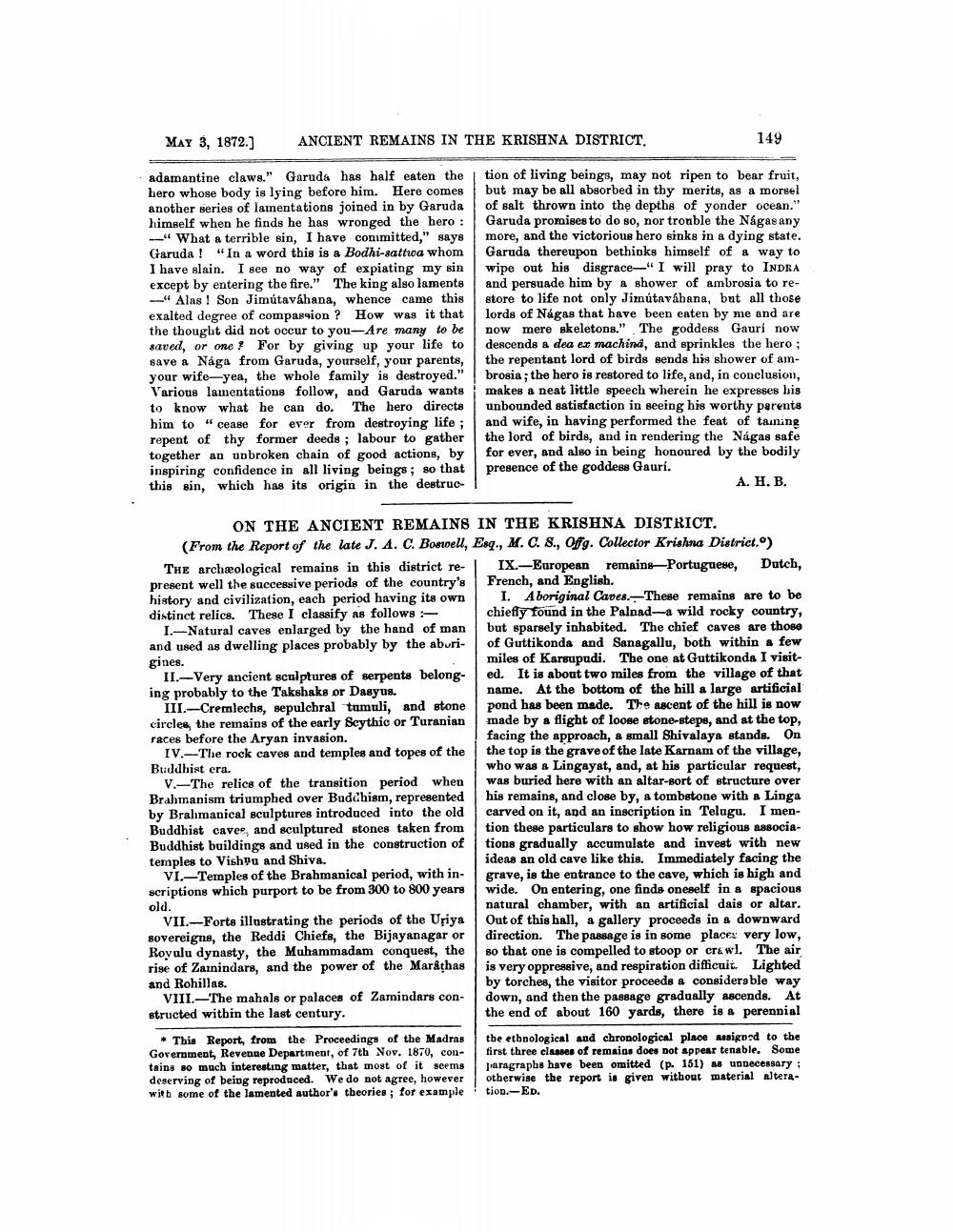________________
MAY 3, 1872.]
adamantine claws." Garuda has half eaten the hero whose body is lying before him. Here comes another series of lamentations joined in by Garuda himself when he finds he has wronged the hero :
"What a terrible sin, I have committed," says Garuda! "In a word this is a Bodhi-sattwa whom I have slain. I see no way of expiating my sin except by entering the fire." The king also laments "Alas! Son Jimútaváhana, whence came this exalted degree of compassion? How was it that the thought did not occur to you-Are many to be saved, or one? For by giving up your life to save a Nága from Garuda, yourself, your parents, your wife-yea, the whole family is destroyed." Various lamentations follow, and Garuda wants to know what he can do. The hero directs him to "cease for ever from destroying life; repent of thy former deeds; labour to gather together an unbroken chain of good actions, by inspiring confidence in all living beings; so that this sin, which has its origin in the destruc
ANCIENT REMAINS IN THE KRISHNA DISTRICT.
ON THE ANCIENT REMAINS IN THE KRISHNA DISTRICT.
(From the Report of the late J. A. C. Boswell,
THE archæological remains in this district represent well the successive periods of the country's history and civilization, each period having its own distinct relics. These I classify as follows:
I.-Natural caves enlarged by the hand of man and used as dwelling places probably by the aburigines.
II. Very ancient sculptures of serpents belonging probably to the Takshaks or Dasyus. III.-Cremlechs, sepulchral tumuli, and stone circles, the remains of the early Scythic or Turanian races before the Aryan invasion.
IV. The rock caves and temples and topes of the Buddhist era.
V. The relics of the transition period when Brahmanism triumphed over Buddhism, represented by Brahmanical sculptures introduced into the old Buddhist caves, and sculptured stones taken from Buddhist buildings and used in the construction of temples to Vishu and Shiva.
VI.-Temples of the Brahmanical period, with inscriptions which purport to be from 300 to 800 years old.
VII.-Forts illustrating the periods of the Uriya sovereigns, the Reddi Chiefs, the Bijayanagar or Royulu dynasty, the Muhammadam conquest, the rise of Zamindars, and the power of the Marathas and Rohillas.
VIII. The mahals or palaces of Zamindars constructed within the last century.
This Report, from the Proceedings of the Madras Government, Revenue Department, of 7th Nov. 1870, contains so much interesting matter, that most of it seems deserving of being reproduced. We do not agree, however with some of the lamented author's theories; for example
149
tion of living beings, may not ripen to bear fruit, but may be all absorbed in thy merits, as a morsel of salt thrown into the depths of yonder ocean." Garuda promises to do so, nor trouble the Nágas any more, and the victorious hero sinks in a dying state. Garuda thereupon bethinks himself of a way to wipe out his disgrace-" I will pray to INDRA and persuade him by a shower of ambrosia to restore to life not only Jimútaváhana, but all those lords of Nágas that have been eaten by me and are now mere skeletons." The goddess Gaurí now descends a dea ex machina, and sprinkles the hero ; the repentant lord of birds sends his shower of ambrosia; the hero is restored to life, and, in conclusion, makes a neat little speech wherein he expresses his unbounded satisfaction in seeing his worthy parents and wife, in having performed the feat of taming the lord of birds, and in rendering the Nágas safe for ever, and also in being honoured by the bodily presence of the goddess Gauri.
A. H. B.
Esq., M. C. S., Offg. Collector Krishna District.") IX.-European remains-Portuguese, French, and English.
Dutch,
I. Aboriginal Caves.-These remains are to be chiefly found in the Palnad-a wild rocky country, but sparsely inhabited. The chief caves are those of Guttikonda and Sanagallu, both within a few miles of Karsupudi. The one at Guttikonda I visited. It is about two miles from the village of that name. At the bottom of the hill a large artificial pond has been made. The ascent of the hill is now made by a flight of loose stone-steps, and at the top, facing the approach, a small Shivalaya stands. On the top is the grave of the late Karnam of the village, who was a Lingayat, and, at his particular request, was buried here with an altar-sort of structure over his remains, and close by, a tombstone with a Linga carved on it, and an inscription in Telugu. I mention these particulars to show how religious associations gradually accumulate and invest with new ideas an old cave like this. Immediately facing the grave, is the entrance to the cave, which is high and wide. On entering, one finds oneself in a spacious natural chamber, with an artificial dais or altar. Out of this hall, a gallery proceeds in a downward direction. The passage is in some places very low, so that one is compelled to stoop or crawl. The air is very oppressive, and respiration difficuit. Lighted by torches, the visitor proceeds a considerable way down, and then the passage gradually ascends. At the end of about 160 yards, there is a perennial
the ethnological and chronological place assigned to the first three classes of remains does not appear tenable. Some paragraphs have been omitted (p. 151) as unnecessary; otherwise the report is given without material alteration.-ED.




